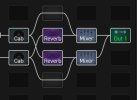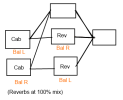WKSmith
Power User
I would like to use a dual IR acoustic stereo path through a reverb while using another reverb inverted with its outputs flipped. And keep it in the FM9 instead of the DAW. I think I can use 2 mixer blocks, but perhaps there is a simple way?
So that the hard panned L path goes to the verb 2 R stereo out and the hard panned R path goes to the verb 2 L stereo out.
Like in this video. At 12:22
So that the hard panned L path goes to the verb 2 R stereo out and the hard panned R path goes to the verb 2 L stereo out.
Like in this video. At 12:22


